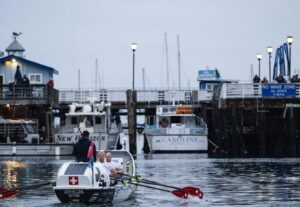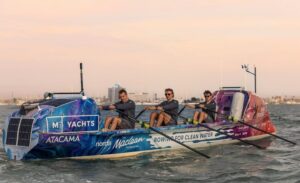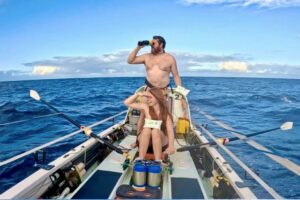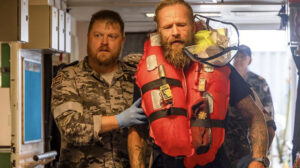Since our last ocean rowing roundup, quite a few records have been claimed. Though most crews have finished their journeys, one soloist is still at sea.
Pacific Ocean
The Pacific Challenge – The inaugural Pacific Challenge came to an end on August 2 when the five-man Flyin’ Fish crew crossed the finish line.
The race, run by the same group that organizes the Talisker Whisky Atlantic Challenge, started on June 12. Fourteen crews and 49 rowers set off on the 4,500km from Monterey, California to Hanalei, Hawaii. Thirteen of the 14 crews crossed the finish line.
The overall winners were a four-man crew called Kiwi Fondue. They finished in 29 days, 17 hours, and 29 minutes. They broke the speed record across the Pacific by an impressive 14 hours.
The next fastest crew was Ocean Warrior, they landed in Hawaii after 31 days, 17 hours, and 12 minutes. The Danish crew of Jens Neergaard, Andreas Dyrby, Joachim Sutton, and Lasse Wulff Hansen were officially the first Scandinavian crew to row the Pacific Ocean. This crew was packed with experience; Hansen has rowed the Atlantic Ocean three times and in 2021 he won the TWAC solo class. Sutton was an Olympic rowing medalist at the 2021 Tokyo Games.

Row Aurora has set a new record as the Fastest Female Trio to cross the Mid-Pacific Ocean. Photo: World’s Toughest Row
There was no shortage of records on the route this year:
- Kiwi Fondue: Fastest Team to Row the Mid-Pacific Ocean (29 days, 17 hours, and 29 minutes)
- Pacific Discovery: Fastest Mixed Four to Row the Mid-Pacific Ocean (34 days, 8 hours, and 22 minutes)
- HODL: Fastest Trio to Row the Mid-Pacific Ocean (38 days, 16 hours, and 19 minutes)
- Row Aurora: Fastest Female Trio to Row the Mid-Pacific Ocean (40 days, four hours, and 52 minutes)
- Flyin’ Fish: Fastest Five to Row the Mid-Pacific Ocean (51 days, five hours, and 44 minutes)
Peru to Australia
Tom Robinson – Robinson (AU) is on the third leg of his row from Lima, Peru to Australia. He initially rowed to Penrhyn, in the Cook Islands, in 160 days. There, he waited four months for the cyclone season to end. He then rowed to American Samoa in 38 days, arriving on May 21. He set off on the third section on July 2 and the Ocean Rowing Society estimates he has now covered 81% of the total distance.
He changed his route slightly after setting off, choosing to stay north of New Caledonia instead of going south. This was based on meteorology reports that predicted less troublesome currents and winds on this route. Another silver lining was that there would be fewer boats to navigate around.
Despite less fierce winds than his original route, the journey north of New Caledonia was still very challenging. On some days winds were so strong that they prevented him from rowing at all.

Tom Robinson is pushed off course by the wind. Photo: Tomrobinsonboats.com
On July 5, Robinson celebrated two key journey markers: he crossed the International Date Line on his 200th-day rowing. But it hasn’t all been smooth sailing in July either; on July 23, for the first time since leaving Peru, Robinson’s tracker showed him moving away from his destination as he battled weather systems that were pushing him around.
This should be the final leg of his journey, but, depending on the weather, he might make another pitstop en route to Queensland.
Indian Ocean
Robert Barton – Barton (AU) completed his 8,358km row from Australia to Tanzania on July 20. In doing so he became the first known person to row solo, non-stop, and unassisted from mainland western Australia to mainland Africa.
On his website, Barton said that he hoped to finish the row in 150 days. He almost cut his target in half, making Tanzania in 85 days, 12 hours, and nine minutes.
An avid sailor, this was Barton’s first ever attempt at rowing an ocean, so he was unsure of how much daily progress he would make when he pushed off from Carnarvon, Australia. He researched how long other rowers had taken to make the crossing, and they took between 120 and 150 days. All of the previous crossings involved at least one stop.
The hardest part of Barton’s journey was the beginning. During the first few days, he was suffering so badly from seas sickness that he turned his boat around and started back to land. After two hours of reflection, he realized he couldn’t give up, spun his boat around, and continued on.
Barton gained the nickname “the naked rower” on social media for forgoing clothes for most of his trip. Speaking to Sunrise Australia, he explained that this was to try and reduce the number of salt sores on his body as he rowed.
After almost three months in a boat, Barton’s first steps back on dry land felt strange. “A final little push for the last mile or so and I was on the beach in front of the yacht club. I had my slightly less than graceful first few steps on land as I staggered around like a drunken sailor. I need to find my land legs,” he commented on social media.
Indi Row 23 – Chris Cleghorn (UK), Allan Huntly (UK), Stephan Easter (UK), and Ben Mann (AU) completed their row from Western Australia to Mauritius on July 19.
The four-man crew covered the 5,900km route in 69 days, 10 hours, and 40 minutes, narrowly missing out on the 67-day speed record they hoped to achieve.

Indi Row 23 in Mauritius. Photo: ior23.com
Though their journey went relatively smoothly, it was not without challenges. They tackled huge waves, Easter dislocated his finger and had to pop it back into place, and on day 68, with the finish line practically in sight, the nut holding the rudder pin sheared off. They tried to fix the rudder as best they could using cable ties and rope.
Grand Baie is a tough area to land because it is surrounded by reefs. The coastguard was on standby to assist but they managed to land without help.
Arctic Ocean
Ocean Revival – Matt Mason, Matthew Inglesby, Mark Sealy, and Colin Hiscock completed their row in the Arctic Circle on July 22. The British crew rowed 1,050km from Tromso in northern Norway across the Barents Sea to Longyearbyen, Svalbard in 15 days, five hours, and 32 minutes.
They are the first four-man crew to tackle this route and broke a number of minor records along the way. Mason is the first person to have rowed across the mid-Atlantic, north Atlantic, and Arctic Oceans, and Inglesby is now the first person to row the Atlantic and Arctic Oceans in the same year.

Ocean Revival completed its arctic row in July. Photo: Ocean Revival
The biggest challenge was the weather. Constant arctic winds and dampness meant that the team was “almost always chilled to the bone,” they wrote on social media. This meant they had to be super disciplined on the boat, “changeovers had to be fast, personal hygiene kept to a high standard and separation of wet and dry kit meticulous.”
The first five days went fairly smoothly, there were no strong winds and very little swell. The team settled into a good rhythm and tried to cover as much distance as they could as they knew the conditions would not last.
They were right. Over the following eight days, they had to spend five on para-anchor. Arctic weather systems can be extremely changeable and the team feared the wind would blow them too far off course. Staying still was a better option and limited the chance of capsizing. In temperatures as low as 2°C, the risks associated with a capsize increase exponentially in the Arctic.
Around mainland UK
Ithaca – Emma Wolstenholme, Amy Wood, Sandra Gates, Emma Hazel, Clair Hennessy, and Margaret Ann Hodge successfully completed their circumnavigation of mainland Britain on July 19. The British six-woman crew set a new women’s speed record on the route. They took 44 days, 20 hours, and 19 minutes to circle the UK clockwise. They started and ended the row at Tower Bridge in London.
Rowing around the UK involved changing tides, busy shipping lanes, and temperamental weather. Their first day on para anchor came on day three because of strong winds, the second on day five, and in total, they were forced to stop rowing for over a week of the challenge to wait for suitable conditions.
They were clear from the beginning that their main goal was to make it around the UK safely while collecting ocean data for the University of Portsmouth. One member of the team was particularly keen to avoid any major accidents. Hazel took part in the GB Row Challenge last year but it ended in dramatic fashion. The coastguard had to rescue Hazel from the Irish Sea after she capsized during a storm with 52-knot winds.
They had intended to row two hours on and two hours off in teams of three. But occasionally conditions were so exhausting that they had to reduce this to one hour off and one hour on. Coming down the east coast was the hardest section. The high winds were constantly against them and the tides turned every six hours. Hazel told Sky News that it was akin to “rowing through lead.”






